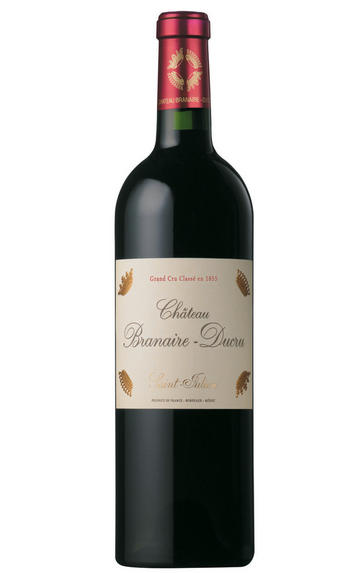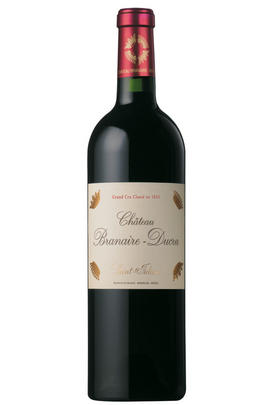
2019 Château Branaire-Ducru, St Julien, Bordeaux

Critics reviews
The 2019 Branaire Ducru has a fresh and vibrant bouquet, very well defined with beautifully integrated oak, quite precise graphite-infused black fruit. The palate is medium-bodied with a ferrous opening, gritty in texture, quite edgy and sharp with an almost citrus fresh, tensile finish. Very fine. Tasted blind at the Southwold annual tasting.
Drink 2025 - 2045
Neal Martin, Vinous.com (January 2023)
The 2019 Branaire-Ducru is rich, layered and sumptuous. Black cherry, licorice, spice, leather tobacco and tar build effortlessly in the glass. The 2019 impresses with its density and pure power, which makes it perhaps atypical for Branaire by its historic standards, but it may be the direction the château seems to be headed in. The aromatics are a bit closed right now, but time in bottle should help take care of that.
Drink 2029 - 2049
Antonio Galloni, Vinous.com (January 2022)
The 2019 Branaire-Ducru is a blend of 56% Cabernet Sauvignon, 35% Merlot, 5% Petit Verdot, and 4% Cabernet Franc. Deep garnet-purple in color, it flies out of the glass with notes of crushed blackcurrants, black cherries, and stewed plums, plus wafts of rose oil, cinnamon toast, and fragrant earth. The medium-bodied palate is juicy and plush, with lively acidity and a spicy finish.
Drink 2026 - 2045
Lisa Perrotti-Brown MW, The Wine Independent (May 2023)
One of the more discreet St Juliens, undergoing a great resurgence right now, and this stands out for its quality and value. Tobacco leaf, baked earth, crushed rocks, crayon and mint leaf set against blueberry and cassis fruits. Balanced, with the finesse of the appellation. Ideally this is put away for another four years or so, but it has the delicacy that makes it just about approachable if you can't wait. I drank it with friends a few months ago, and nobody was complaining. 43hl/h yield.
Drink 2026 - 2040
Jane Anson, Inside Bordeaux (December 2023)
Tasted blind. Deep, luscious crimson. Rich, tea-leaf nose and lots of vigour. Marked acidity, but lots of fruit and tannin too. But not incredibly tightly knit.
Drink 2028 - 2042
Jancis Robinson MW, JancisRobinson.com (January 2023)
The 2019 Branaire-Ducru unwinds in the glass with aromas of raspberries, blackcurrants, sweet soil tones and hints of cigar wrapper, rose petals and cedar. Medium to full-bodied, deep and layered, it's youthfully tightly wound, with terrific concentration, tangy acids, powdery tannins and a long, saline finish. While this is a little reserved out of the gates, its energy and classical proportions will richly reward bottle age.
Branaire-Ducru occupies 60 hectares of deep gravel soils, in 80 or so different parcels, on the plateau of Beychevelle. Cabernet Sauvignon dominates, but plantings of Petit Verdot on good soils are also a particularity of Branaire. When the Maroteaux family purchased the estate in 1988, a new winery followed a few years later; and now, another is under construction, which will almost double the number of fermentation vats, permitting more precise parcel-by-parcel vinification. Winemaking is very classical, and maturation is in around 60% new oak, with three or four traditional rackings. There are no smoke or mirrors at this address, just extremely good, age-worthy Saint-Julien that's always elegant and impeccably balanced. The 2019 vintage has turned out especially well and is worth a special effort to seek out.
Drink 2029 - 2065
William Kelley, Wine Advocate (April 2022)
Tempting nose, full of aromatic black fruits, perfume, liquorice and salty stones. Juicy, ripe, and controlled, I love the upfront nature of this, bright, lively energy, you can feel the concentration in the chalky, dry just-spiced edges on the tongue, giving a piquance, but the acidity, soft sweetness and roundness is there. Such a beautiful expression, refined and finessed, charming and precise. The detail and nuance is there covered slightly by the ripe cherry and strawberry fruit but there is such joy to this. Charming and classic in the best way.
Drink 2026 - 2050
Georgina Hindle, Decanter.com (October 2023)
About this WINE

Château Branaire-Ducru
Classified as a fourth growth in 1855, Ch. Branaire-Ducru makes pure and classic St Julien. The estate has recently passed from father to son: the widely respected Patrick Maroteaux – who had served at various times as president of the Union des Grands Crus de Bordeaux and the St Julien appellation – sadly passed away in 2017. His son François-Xavier has picked up the baton and continues his father’s legacy. The Maroteaux family bought the property in 1988 and have invested considerably in the vineyard and winery since. Superstar consultant Eric Boissenot advises here, as he does with many of the Left Bank’s top estates, including the Médoc’s four first growths.

St Julien
St Julien is the smallest of the "Big Four" Médoc communes. Although, without any First Growths, St Julien is recognised to be the most consistent of the main communes, with several châteaux turning out impressive wines year after year.
St Julien itself is much more of a village than Pauillac and almost all of the notable properties lie to its south. Its most northerly château is Ch. Léoville Las Cases (whose vineyards actually adjoin those of Latour in Pauillac) but, further south, suitable vineyard land gives way to arable farming and livestock until the Margaux appellation is reached.
The soil is gravelly and finer than that of Pauillac, and without the iron content which gives Pauillac its stature. The homogeneous soils in the vineyards (which extend over a relatively small area of just over 700 hectares) give the commune a unified character.
The wines can be assessed as much by texture as flavour, and there is a sleek, wholesome character to the best. Elegance, harmony and perfect balance and weight, with hints of cassis and cedar, are what epitomise classic St Julien wines. At their very best they combine Margaux’s elegance and refinement with Pauillac’s power and substance.
Ch. Léoville Las Cases produces arguably the most sought-after St Julien, and in any reassessment of the 1855 Classification it would almost certainly warrant being elevated to First Growth status.
Recommended Châteaux: Ch. Léoville Las Cases, Ch.Léoville Barton, Ch Léoville Poyferré, Ch. Ducru-Beaucaillou, Ch Langoa Barton, Ch Gruaud Larose, Ch. Branaire-Ducru, Ch. Beychevelle

Cabernet Sauvignon Blend
Cabernet Sauvignon lends itself particularly well in blends with Merlot. This is actually the archetypal Bordeaux blend, though in different proportions in the sub-regions and sometimes topped up with Cabernet Franc, Malbec, and Petit Verdot.
In the Médoc and Graves the percentage of Cabernet Sauvignon in the blend can range from 95% (Mouton-Rothschild) to as low as 40%. It is particularly suited to the dry, warm, free- draining, gravel-rich soils and is responsible for the redolent cassis characteristics as well as the depth of colour, tannic structure and pronounced acidity of Médoc wines. However 100% Cabernet Sauvignon wines can be slightly hollow-tasting in the middle palate and Merlot with its generous, fleshy fruit flavours acts as a perfect foil by filling in this cavity.
In St-Emilion and Pomerol, the blends are Merlot dominated as Cabernet Sauvignon can struggle to ripen there - when it is included, it adds structure and body to the wine. Sassicaia is the most famous Bordeaux blend in Italy and has spawned many imitations, whereby the blend is now firmly established in the New World and particularly in California and Australia.


Buying options
Add to wishlist
Description
This is a wine of precision and elegance, the hallmark of the château. Tasted against its peers, Branaire’s intellectual restraint and modesty stood out this year. It carries the volume of the vintage very well and, without showing the extremes of the year, there are interesting notes of bilberry and raspberry. A beautifully composed Branaire. Drink 2026-2040.
Blend: 56% Cabernet Sauvignon, 35% Merlot, 5% Petit Verdot, 4% Cabernet Franc
Berry Bros. & Rudd
wine at a glance
Delivery and quality guarantee